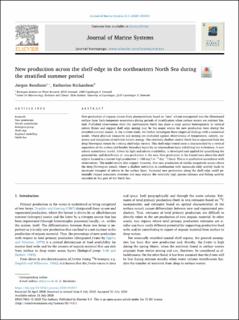| dc.contributor.author | Bendtsen, Jørgen | |
| dc.contributor.author | Richardson, Katherine | |
| dc.date.accessioned | 2020-10-27T15:13:23Z | |
| dc.date.available | 2020-10-27T15:13:23Z | |
| dc.date.created | 2020-09-30T11:14:45Z | |
| dc.date.issued | 2020 | |
| dc.identifier.citation | Journal of Marine Systems. 2020, 211. | en_US |
| dc.identifier.issn | 0924-7963 | |
| dc.identifier.uri | https://hdl.handle.net/11250/2685356 | |
| dc.description.abstract | New production of organic matter from photosynthesis based on “new” nitrate transported into the illuminated surface layer fuels temperate ecosystems during periods of stratification when surface waters are nutrient limited. Published observations from the northeastern North Sea show a large spatial heterogeneity in vertical nitrate fluxes and suggest shelf edge mixing may be the major source for new production here during the stratified summer season. In the current study, we further investigate these empirical findings with a numerical model, where physical transports and mixing are evaluated against observations of temperature, salinity, nutrients and dissipation of turbulent kinetic energy. The relatively shallow central North Sea is separated from the deep Norwegian trench by a strong shelf edge current. This shelf edge frontal zone is characterized by a vertical separation of the surface and benthic boundary layers by an intermediate layer exhibiting low turbulence. A new nitrate assimilation model, driven by light and nitrate availability, is developed and applied for quantifying the potential for, and distribution of, new production in the area. New production in the frontal zone above the shelf edge is located in a narrow high productive (~100 mg C m−2 day−1) band. This is in qualitative accordance with observations. The model results also suggest, however, that new production of similar magnitude occurs above the deep Norwegian trench, where a shallow nutricline in combination with mesoscale eddy activity leads to increased transport of nitrate to the surface layer. Increased new production along the shelf edge could potentially impact ecosystem structure and may explain the relatively high species richness and fishing activity recorded in this part of the North Sea. | en_US |
| dc.language.iso | eng | en_US |
| dc.publisher | Elsevier | en_US |
| dc.rights | Navngivelse 4.0 Internasjonal | * |
| dc.rights.uri | http://creativecommons.org/licenses/by/4.0/deed.no | * |
| dc.title | New production across the shelf-edge in the northeastern North Sea during the stratified summer period | en_US |
| dc.type | Peer reviewed | en_US |
| dc.type | Journal article | en_US |
| dc.description.version | publishedVersion | en_US |
| dc.rights.holder | © 2020 The Authors | en_US |
| dc.source.volume | 211 | en_US |
| dc.source.journal | Journal of Marine Systems | en_US |
| dc.identifier.doi | 10.1016/j.jmarsys.2020.103414 | |
| dc.identifier.cristin | 1835425 | |
| dc.source.articlenumber | 103292 | en_US |
| cristin.ispublished | true | |
| cristin.fulltext | original | |
| cristin.qualitycode | 1 | |

